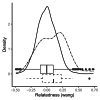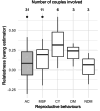Parentage Analysis in a Green Sea Turtle (Chelonia mydas) Population From French Polynesia Reveals a Tendency for Inbreeding and Unexpected Plasticity in Reproductive Behaviour
- PMID: 40671723
- PMCID: PMC12264388
- DOI: 10.1002/ece3.70855
Parentage Analysis in a Green Sea Turtle (Chelonia mydas) Population From French Polynesia Reveals a Tendency for Inbreeding and Unexpected Plasticity in Reproductive Behaviour
Abstract
The reproductive systems of natural populations can significantly impact their genetic diversity by either preventing or promoting inbreeding. Therefore, it is crucial to have a comprehensive understanding of the mating system to evaluate a population's ability to maintain genetic diversity over time. In this study, we examine the mating system of an endangered population of green sea turtles in Tetiaroa, French Polynesia. We determine if different mating behaviours serve as strategies to avoid inbreeding. We genotyped 107 nesting females and 1483 hatchlings from 549 nests and used 23 microsatellite markers to reconstruct the genotypes of the sires. We assessed the level of inbreeding and relatedness among the parent pairs and explored the correlation between relatedness and indicators of reproductive success. We investigated the mating behaviours of both males and females and determined whether specific behaviours were linked to different levels of relatedness. We explored for the first time the relatedness bias of mating behaviours in green turtles. Our results showed that the global F is was significant in the population, and the levels of relatedness were higher than expected through random mating, indicating inbreeding and non-random partner selection for related mates. No mating behaviours were associated with lower relatedness levels, suggesting inbreeding tolerance or preference in this population. Finally, we discovered unexpected plasticity in the reproductive frequency of females, the length of the inter-nesting interval, and the relative timing of breeding and nesting. If confirmed in other populations and with a larger sample size, these new findings may reshape our understanding of the green turtle's intricate reproductive system.
Les systèmes de reproduction des populations naturelles peuvent avoir un impact significatif sur leur diversité génétique en empêchant ou en favorisant la consanguinité. Il est donc essentiel d'avoir une compréhension globale de ces systèmes pour évaluer la capacité d'une population à maintenir la diversité génétique au fil du temps. Dans cette étude, nous examinons le système de reproduction d'une population menacée de tortues vertes à Tetiaroa, en Polynésie française. Nous déterminons si différents comportements de reproduction servent de stratégies pour éviter la consanguinité. Nous avons génotypé 107 femelles pondeuses et 1483 nouveau‐nés provenant de 549 nids, et utilisé 23 marqueurs microsatellites pour reconstruire les génotypes des pères. Nous avons évalué le niveau de consanguinité et de parenté entre les paires de parents et exploré la corrélation entre la parenté et les indicateurs de succès de la reproduction. Nous avons étudié les comportements de reproduction des mâles et des femelles et déterminé si des comportements spécifiques étaient liés à différents niveaux de similarité génétique. Nos résultats ont montré que le F is global était significatif dans la population et que les niveaux de parenté étaient plus élevés que dans un scénario d'accouplements aléatoires, indiquant une consanguinité et une sélection non aléatoire de partenaires. Aucun comportement d'accouplement n'a été associé à des niveaux de similarité génétique inférieurs à ceux de la population générale, suggérant une tolérance ou une préférence de consanguinité dans cette population. Enfin, nous avons découvert une plasticité inattendue dans la fréquence de reproduction des femelles, la durée de l'intervalle entre les nidifications et entre la reproduction et la nidification. Si elles sont confirmées dans d'autres populations et avec un échantillon plus large, ces nouvelles découvertes pourraient remodeler notre compréhension du système reproducteur complexe de la tortue verte.
Keywords: genotype reconstruction; inbreeding; mating behaviour; multiple paternity; relatedness; reproductive success.
© 2025 The Author(s). Ecology and Evolution published by John Wiley & Sons Ltd.
Conflict of interest statement
The authors declare no conflicts of interest.
Figures








Similar articles
-
Systemic pharmacological treatments for chronic plaque psoriasis: a network meta-analysis.Cochrane Database Syst Rev. 2021 Apr 19;4(4):CD011535. doi: 10.1002/14651858.CD011535.pub4. Cochrane Database Syst Rev. 2021. Update in: Cochrane Database Syst Rev. 2022 May 23;5:CD011535. doi: 10.1002/14651858.CD011535.pub5. PMID: 33871055 Free PMC article. Updated.
-
Behavioral interventions to reduce risk for sexual transmission of HIV among men who have sex with men.Cochrane Database Syst Rev. 2008 Jul 16;(3):CD001230. doi: 10.1002/14651858.CD001230.pub2. Cochrane Database Syst Rev. 2008. PMID: 18646068
-
Immunogenicity and seroefficacy of pneumococcal conjugate vaccines: a systematic review and network meta-analysis.Health Technol Assess. 2024 Jul;28(34):1-109. doi: 10.3310/YWHA3079. Health Technol Assess. 2024. PMID: 39046101 Free PMC article.
-
Systemic pharmacological treatments for chronic plaque psoriasis: a network meta-analysis.Cochrane Database Syst Rev. 2017 Dec 22;12(12):CD011535. doi: 10.1002/14651858.CD011535.pub2. Cochrane Database Syst Rev. 2017. Update in: Cochrane Database Syst Rev. 2020 Jan 9;1:CD011535. doi: 10.1002/14651858.CD011535.pub3. PMID: 29271481 Free PMC article. Updated.
-
Signs and symptoms to determine if a patient presenting in primary care or hospital outpatient settings has COVID-19.Cochrane Database Syst Rev. 2022 May 20;5(5):CD013665. doi: 10.1002/14651858.CD013665.pub3. Cochrane Database Syst Rev. 2022. PMID: 35593186 Free PMC article.
References
-
- Allen, C. D. , Martin S. L., and Jones T. T.. 2023. “IUCN Red List of Threatened Species: <styled-content style="fixed-case"> Chelonia mydas </styled-content> Central South Pacific Subpopulation. IUCN Red List Threat Species.” 10.2305/IUCN.UK.2023-1.RLTS.T220353080A220353155.en. - DOI
-
- Anthony, L. L. , and Blumstein D. T.. 2000. “Integrating Behaviour Into Wildlife Conservation: The Multiple Ways That Behaviour Can Reduce ne.” Biological Conservation 95: 303–315. 10.1016/S0006-3207(00)00037-9. - DOI
-
- Baer, B. , Schmid‐Hempel P., Høeg J. T., and Boomsma J. J.. 2003. “Sperm Length, Sperm Storage and Mating System Characteristics in Bumblebees.” Insectes Sociaux 50: 101–108. 10.1007/s00040-003-0641-0. - DOI
-
- Bailleul, D. , Stoeckel S., and Arnaud‐Haond S.. 2016. “RClone: A Package to Identify MultiLocus Clonal Lineages and Handle Clonal Data Sets in r.” Methods in Ecology and Evolution 7: 966–970. 10.1111/2041-210X.12550. - DOI
LinkOut - more resources
Full Text Sources

